Space Physics Images
Images from the Otago Space Physics Group, at Home and Overseas
| The annual Space Physics image was updated Friday 19 September 2025. From left to right: Neil Thomson, Ouji Kurimura, Craig Rodger, Hannah Kessenich, James Brundell, Lisa Evans, Mikhail Kruglyakov, Johnny Malone-Leigh, Daniel Mac Manus, Xinhu Feng, and Annika Seppälä. Unfortunately, CJ Barnes-Wilkie and Delta Cox missed the photo this year [19 September 2025] | 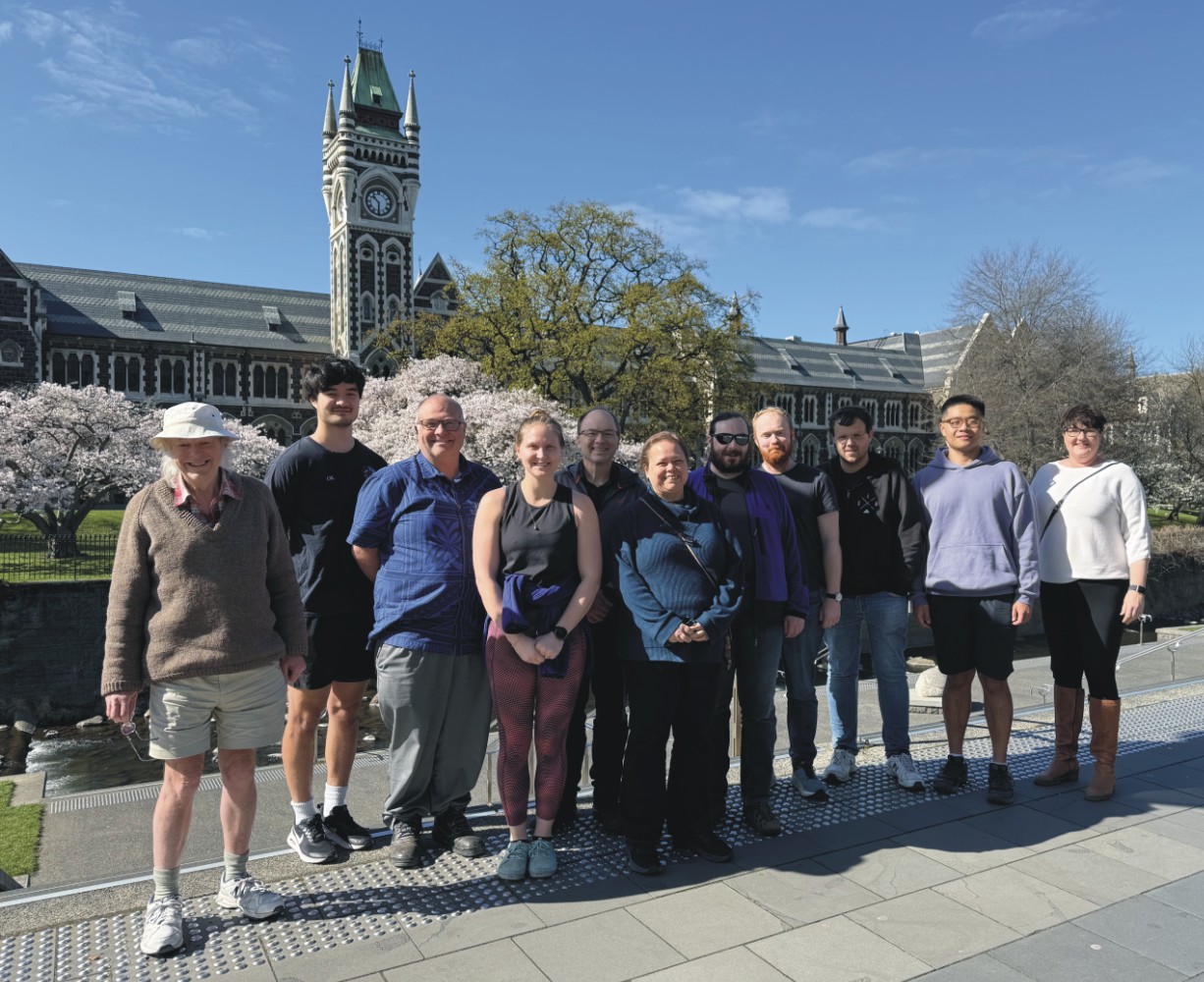 |
| In August-September 2025 a large team from the Otago Space Physics group headed to Lisbon in Portugal. During the meeting we heard that the Solar Tsunamis: Next Generation proposal was to be funded. The images shows a team dinner at the Cafe Imperio in Lisbon the evening after we heard. From left to right: Mark Clilverd (British Antarctic Survey), Daniel Mac Manus (Otago), Lisa Evans (Otago), Tim Divett (VUW), Xinhu Feng (Otago), Johnny Malone-Leigh (Otago), Craig Rodger (Otago), Gillian Turner (VUW) and Malcolm Ingham (VUW) [4 September 2025]. | 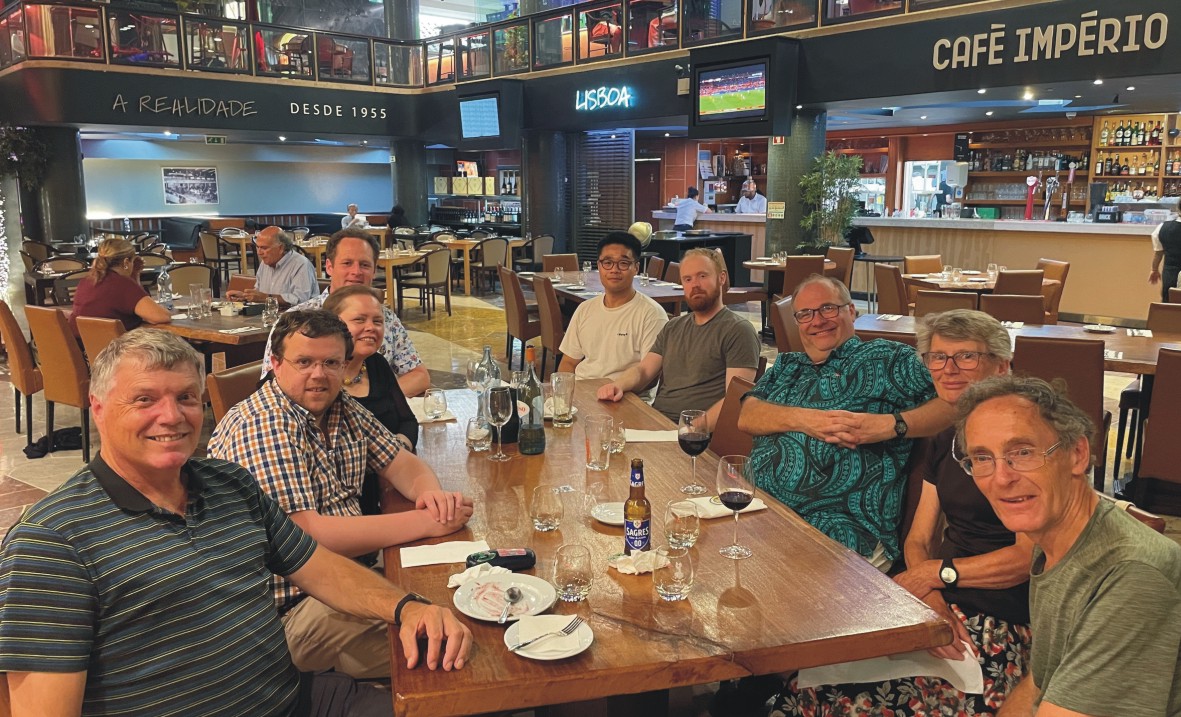 |
| In August-September 2025 a large team from the Otago Space Physics group headed to Lisbon in Portugal. We travelled to attend the IAGA / IASPEI Joint Scientific Meeting 2025, which ran from 31 August to 5 September. This image shows from left to right Johnny Malone-Leigh (Otago), Lisa Evans (Otago), Darcy Cordell (Alberta), Daniel Mac Manus (Otago), and Xinhu Feng (Otago). The team had headed to Sintra to see a different side of Lisbon at the end of the meeting [5 September 2025] | 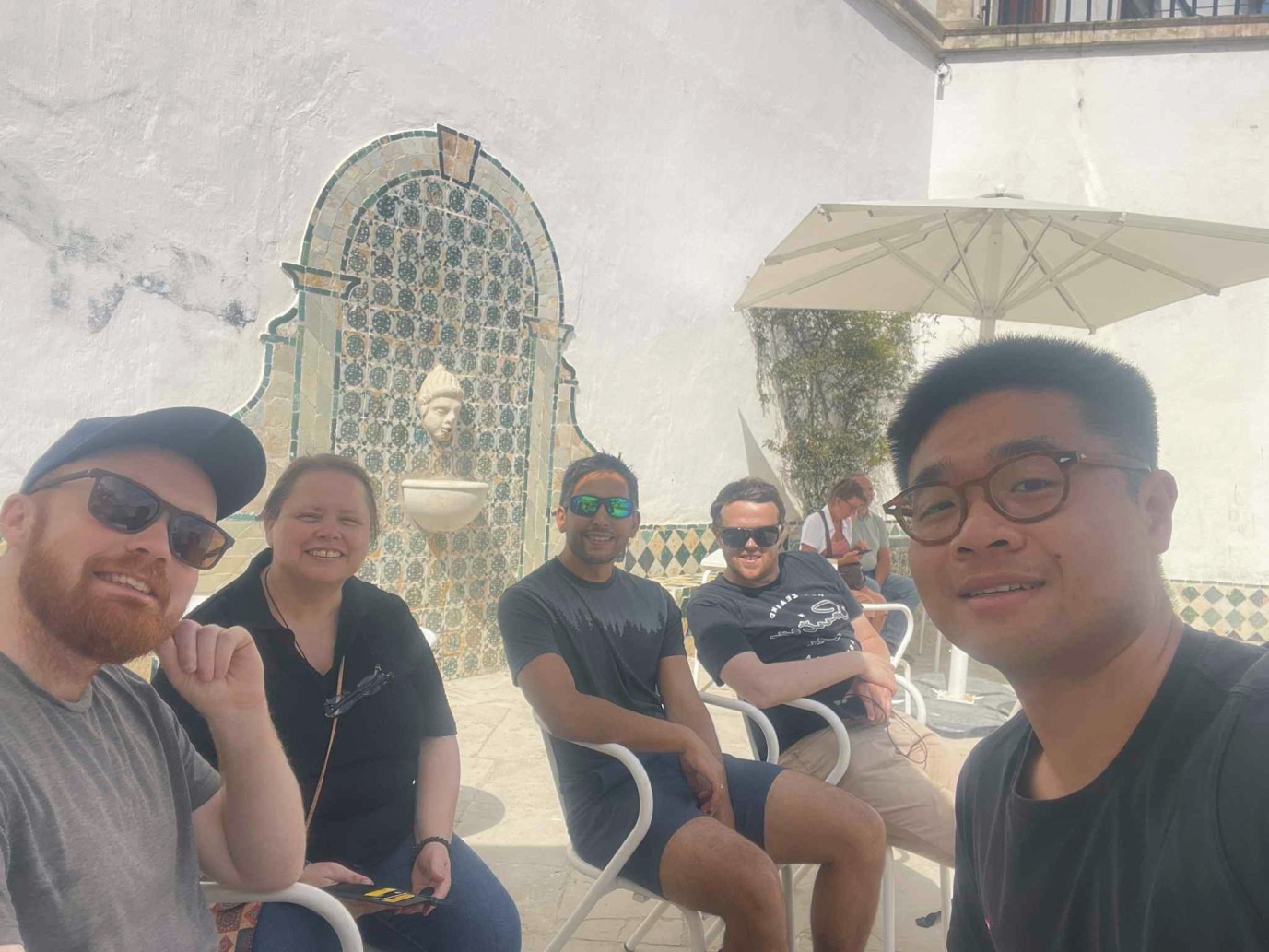 |
| In August-September 2025 a large team from the Otago Space Physics group headed to Lisbon in Portugal. We travelled to attend the IAGA / IASPEI Joint Scientific Meeting 2025, which ran from 31 August to 5 September. This image shows Craig Rodger just after the conference. He is standing at the top of the Parque Eduardo VII [5 September 2025]. | 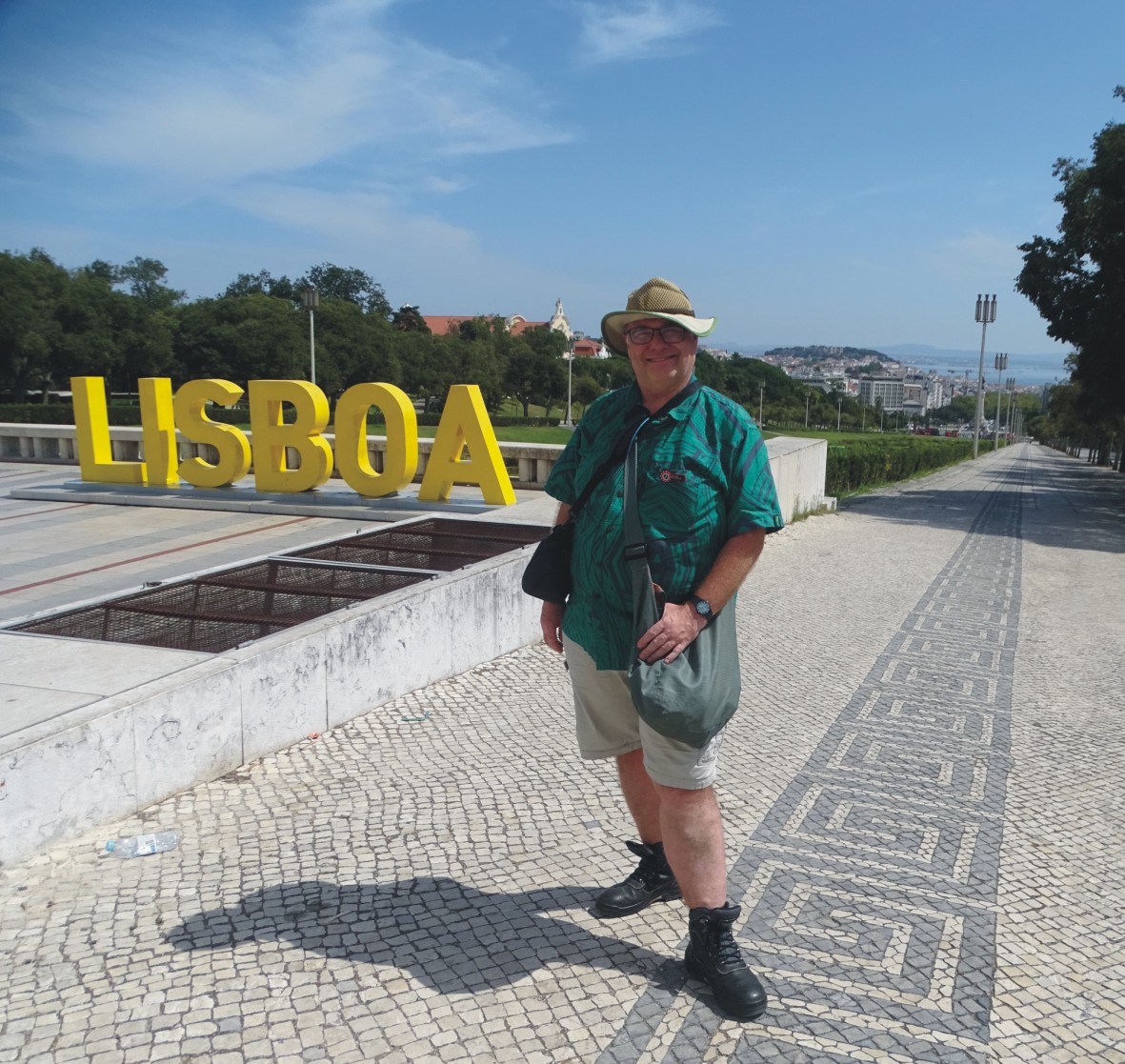 |
| We were fortunate to host three colleagues from the United Kingdom in late June/early July 2025. This image shows Andy Smith (Northumbria University), Gemma Richardson (British Geological Survey), and Mark Clilverd (British Antarctic Survey). As Mark, Gemma, and Andy are active in research around space weather, they were keen to see the Halfway Bush Substation in the hills of Dunedin – Transformer #4 at this substation was damaged by a space weather event in November 2001. | 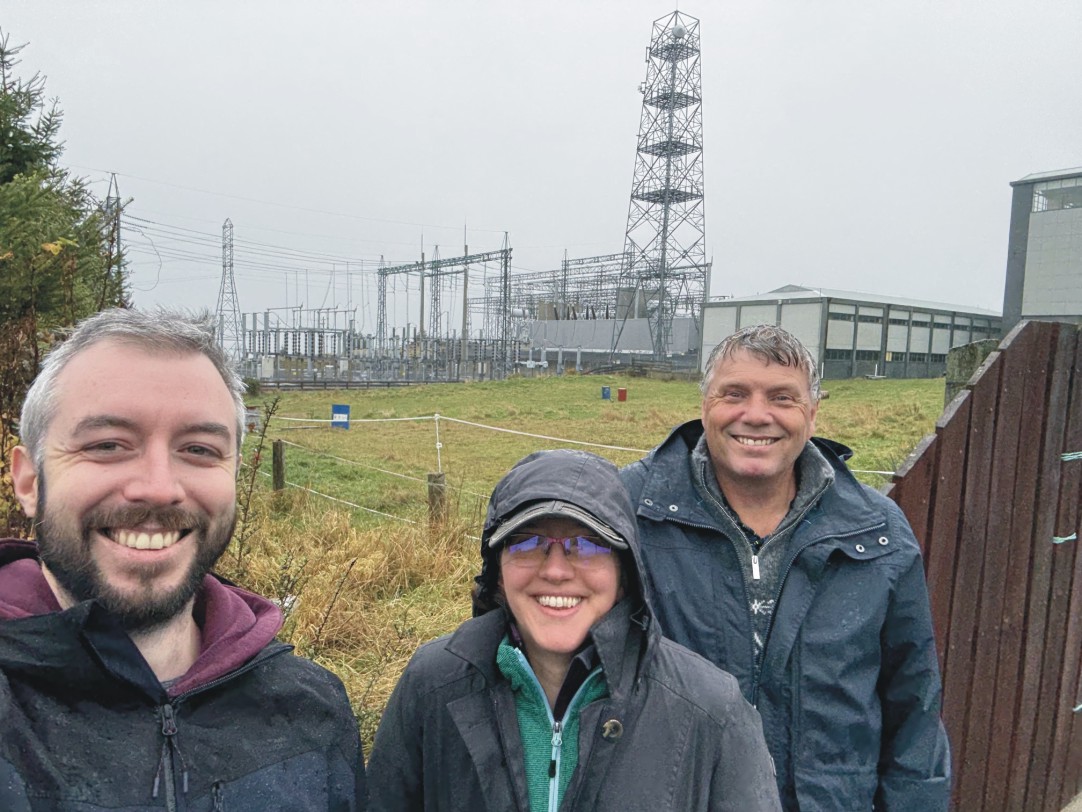 |
| In late June 2025 we hosted the Year 5 meeting of the Solar Tsunamis research programme at the University of Otago. Attendees included researchers and collaborators from Canterbury University, Victoria University of Wellington, GNS Science, British Antarctic Survey, British Geological Survey, and the University of Northumbria. Also attending were industry representatives from Transpower, the team from Tūhura Otago Museum who provided outreach for the project, and staff representing the project’s funders from MBIE. Other collaborators were able to join the meeting virtually from the UK, Switzerland, the US, and Canada [25 June 2025]. | 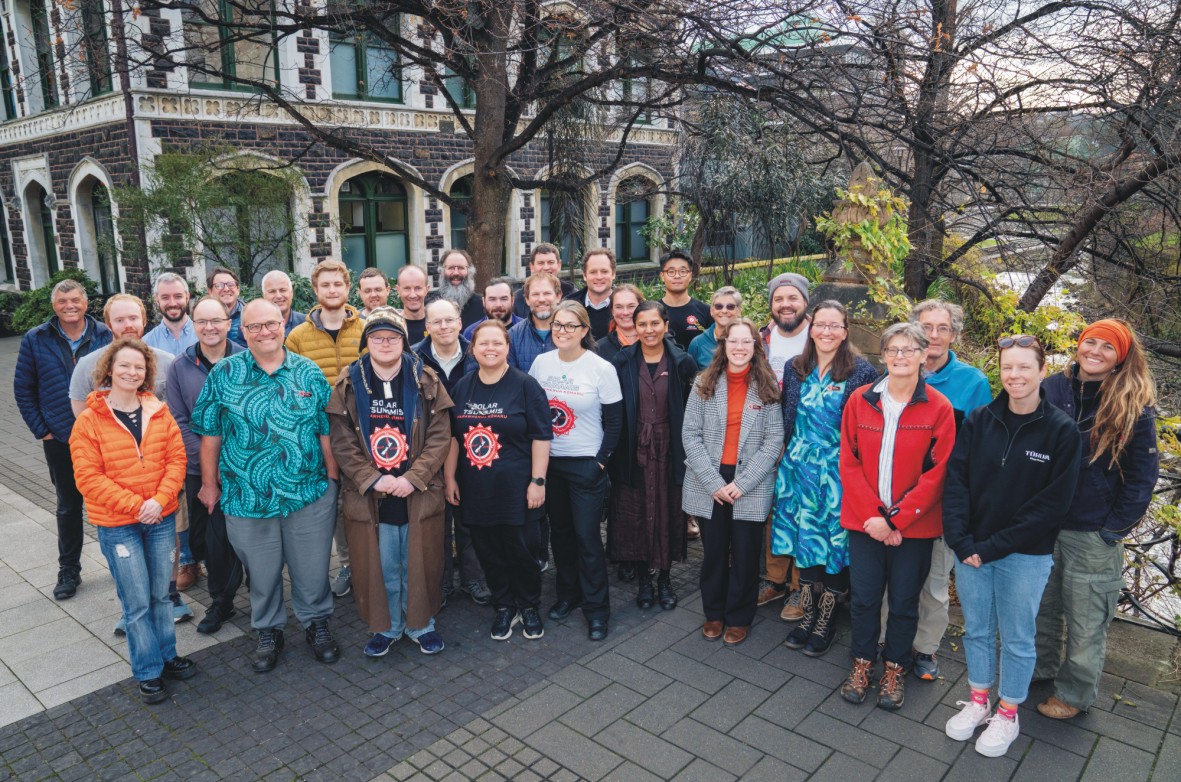 |
| As the Solar Tsunamis project drew to an end (2020-2025), the VUW team focused on modelling Space Weather impacts on gas pipelines visited our industry partners in New Plymouth, along with Craig. The image shows Tim Divett (VUW), Malcolm Ingham (VUW), corrosion protection engineer Mark Sigley (Clarus), and Craig outside the Clarus building. Clarus group was formally known as Firstgas Group Ltd. [13 June 2025]. | 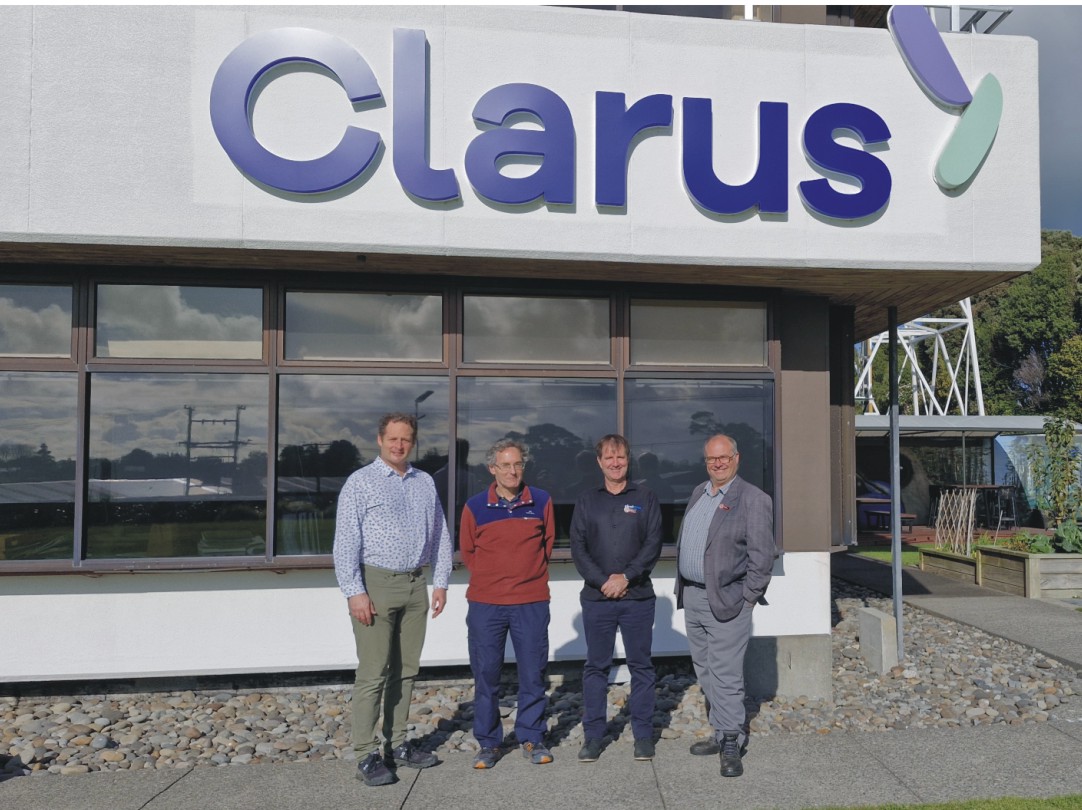 |
| In May-June 2025 Craig travelled to the UK. The main goal was to visit collaborators from the British Geological Survey in Edinburgh and Northumbria University in Newcastle upon Tyne. He also spent most of the time travelling with Mark Clilverd from the British Antarctic Survey. At the start of the time Craig and Mark dropped by the Jodrell Bank Centre for Engagement to see the historic radio telescope there [25 May 2025]. | 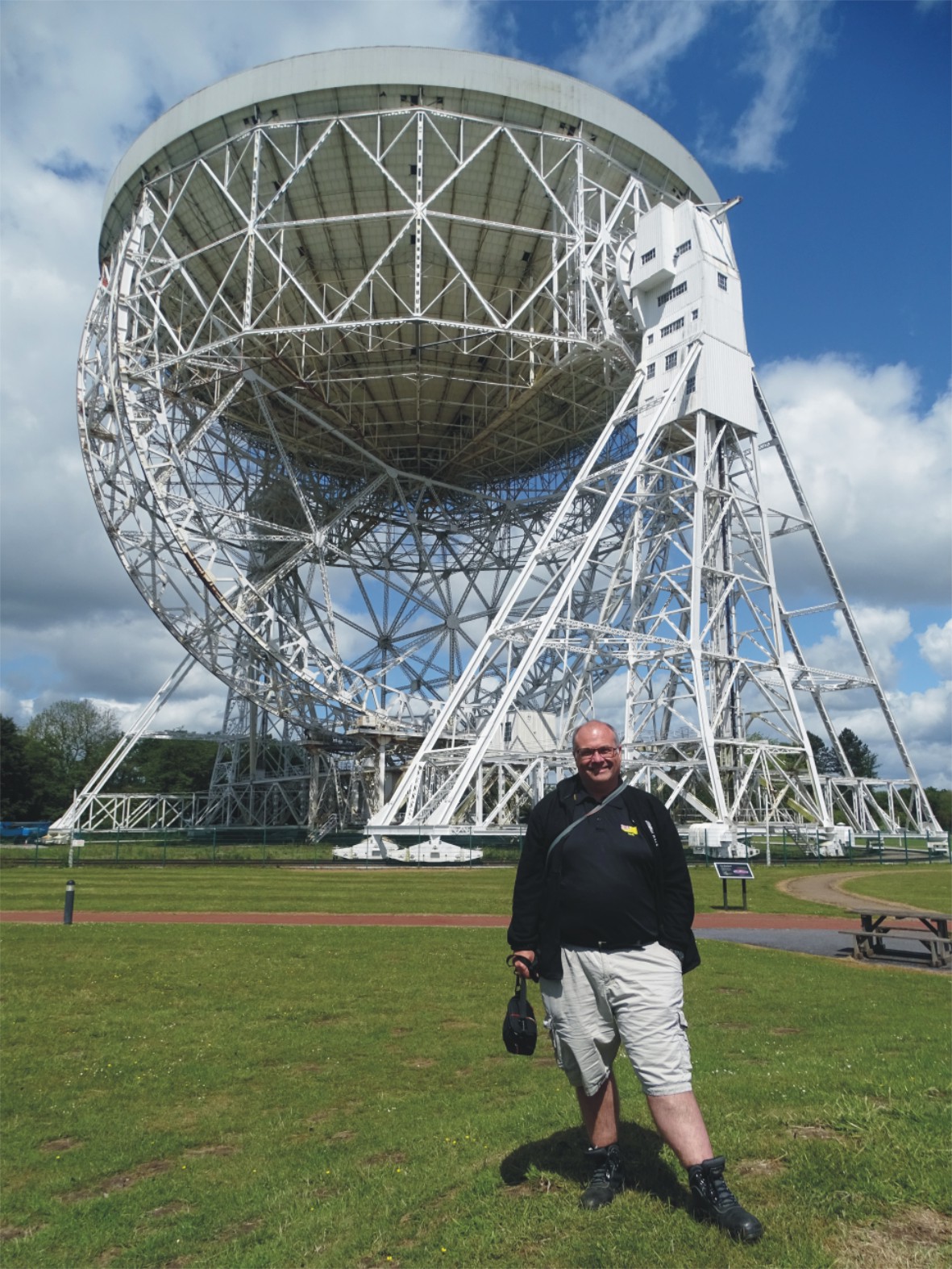 |
| Solar Tsunamis collaborators Dr Pauline Dredger and Dan Welling visited the Otago Space Physics group in May 2025. During their time in Dunedin they attended a rugby match at the Forsyth Barr Stadium. The match was between the Highlanders and Moana Pasifika, as was their first introduction to rugby – the image shows them trying to read the rules of the game [4 May 2025]. | 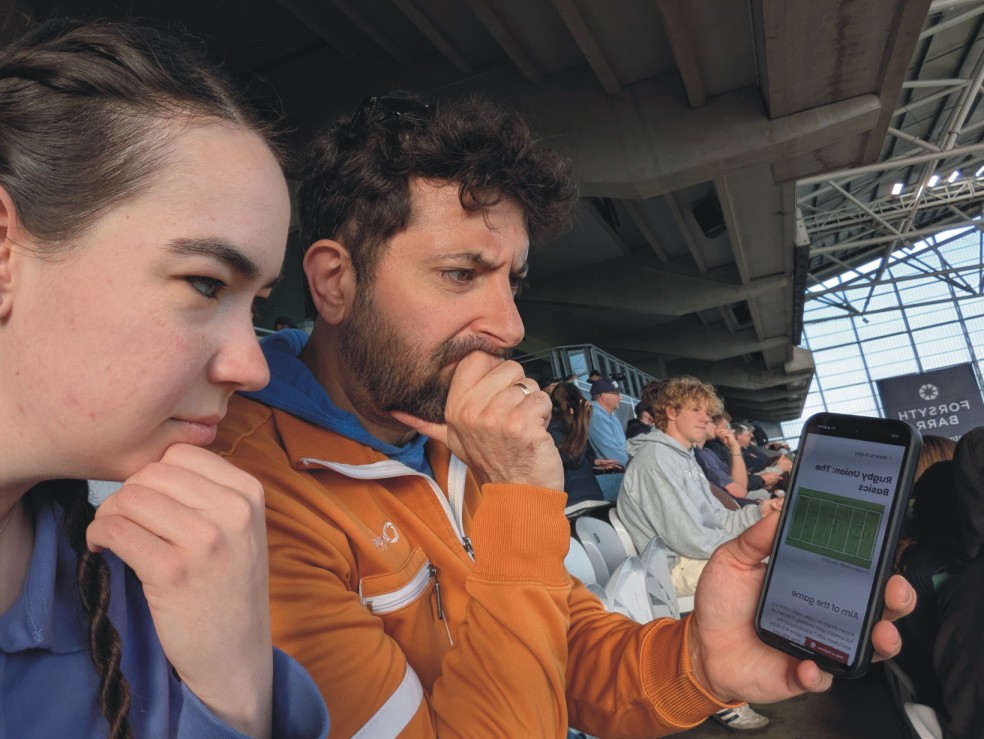 |
| In late March 2025 the Solar Tsunamis team took at the Solar Tsunamis education and outreach roadshow to the New Zealand Parliament. We were able to set the roadshow up in the Banquet Hall inside the Beehive, hosted by Scott Willis MP. The roadshow was reinforced by our planetarium show, Waihiko me te Parawhenua Kōmaru (Waihiko and the Solar Tsunami). The picture shows Marijn Kouwenhoven (Tūhura Otago Museum) and Craig Rodger draining water from the grid game as we packed up after the event [26 March 2025]. |  |
| The New Zealand team who attended the 2025 US Space Weather Workshop in Boulder, Colorado. From left to right: Tom Wilson [NEMA], Craig Rodger [Otago], Dwain Hindriksen [NEMA], Jono Hanson [GNS], Andrew Renton [Transpower], and Daniel Mac Manus [Otago]. This image was taken during our end of workshop debrief as BJ’s across the road from the conference hotel. It was also Tom Wilson’s birthday, hence the candle in the cookie [14 March 2025]. |  |
| In early March Lloyd’s of London had a series of space weather information events. Craig Rodger was asked to attend these to provide information on the risk to electricity networks and supply. One of the events was the launch of the “Life in the Sun’s Atmosphere” photography exhibition by Max Alexander, in Lloyd’s London HQ. That included a panel discussion which Craig was part of, shortly after the opening by the Lloyd’s chairman and a UK cabinet minister. This image shows Craig next to a picture from the exhibition showing the Tiwai Smelter, which would be strongly at risk during an extreme space weather event [4 March 2025]. |  |
| Otago Space Physics Expedition 16 returned to New Zealand late on Wednesday 12 February 2025. There year there was no travel delays or disruptions, and everything was smooth. During their time they spent significant effort trying to fix a noise problem with the electric field antenna shown in this image. This picture shows expedition members Dr Johnny Malone-Leigh and Dr James Brundell at the electric field we have near Scott Base [10 February 2025] |  |
| Dr James Brundell and Dr. Johnny Malone-Leigh about to leave Christchurch on the way to Antarctica. James and Johnny flew onboard a Lockheed C-130H of the Nevada Air Guard US Air Force, aircraft High Rollers93-7314 with call-sign ROLER14. Johnny and James are Otago Space Physics Expedition 16, which made a short trip to Scott Base in February 2025. This is James’ 15th trip to Antarctica, and Johnny’s 1st [3 February 2025]. |  |
| From mid-January to early February 2025 Assoc. Prof. Claudia Martinez visited us from ISEE in Nagoya University. Along with many detailed science conversations, Claudia was able to explore in and around the city of Dunedin. This image shows her near the end of Karetai Track on Otago Peninsula, looking south. It is just as well Claudia brought a hat, as we had summer during her time with us. |  |
| We started 2025 with the second injection campaign occurring in the wider Wellington region. More information on the first campaign can be found on the Solar Tsunamis website. This time the focus was one two substations, Haywards and Wilton. This image shows Transpower engineer Mike Dalzell and Craig Rodger in front of WIL T8, the main transformer in the Wilton substation [6 Jan 2025]. |  |
| In December Daniel Mac Manus attending the 2024 Fall Meeting of the American Geophysical Union. The meeting was held in Washington DC, so like any sensible Space Physicist, Daniel visited the Smithsonian Air & Space Museum. He travelled to both the main branches, including this picture taken with the Space Shuttle Discovery at the Udvar-Hazy Center [12 December 2024]. |  |
| In late November 2024 the team went south towards the bottom of the island to do upgrades to our MANA magnetometer site at Awarua. Local noise issues meant we had data quality, so we moved the magnetic field variometer and installed a fully solar power system. The site choosen was surrounded by bush, and the install was very hard work – and very muddy too. The picture shows Dr. Johnny Malone-Leigh, Dr. James Brundell, and PhD student Xinhu Feng after they got the gear set up [21 Nov 2024]. |  |
| After London, Craig travelled to Portugal, to attend the European Space Weather Week conference held in Coimbra (4-8 November 2024). The day before the meeting Craig visited the University of Coimbra as a tourist – one of the oldest Universities of Europe (established in 1290). The visit included the “Physics Cabinet” of the Science Museum, which has a historic Physics lecture theatre and a display of Physics demonstrations [3 Nov 2024]. |  |
| Moving on from College Park and the GIC workshop, Craig then travelled to London. While there he attended a meeting to discuss the Solar Tsunamis research work with space weather-linked people in the UK. The meeting was hosted by the Department for Energy Security and Net Zero (Desnz) at the Old Admiralty Building in Whitehall. Attendees included staff from Desnz, UK Met Office, National Grid and National Energy System Operator (NESO), Fraser-Nash, BAS, BGS, and Lancaster University. The image shows Craig leaving the building at the end of the meeting [28 October 2024]. |  |
| Johnny Malone-Leigh and Craig Rodger travelled to College Park (Maryland, USA) in October 2024. They went to the University of Maryland to attend the 2024 Workshop on Geomagnetically Induced Currents supported by the US National Science Foundation. Johnny is standing in front of the H.J. Patterson Hall in the main campus [October 2024]. |  |
| After his time in Christchurch to attend the 2024 National Lifeline Utilities Forum (image below) Craig travelled to the east coast of the USA, heading for the University of Maryland in College Park. Craig and Johnny Malone-Leigh went to UMD to attend the 2024 Workshop on Geomagnetically Induced Currents supported by the US National Science Foundation. During the meeting we often ate lunch at the Stamp Student Union building – and outside of this was a statue of ex-UMD student and Muppet creator Jim Henson (this photo taken 23 Oct 2024). |  |
| From late August 2024 to late October PhD student Shannon Killey visited the Otago Space Physics group from Northumbria University. Shannon came to talk to us about radiation belt precipitation. During her time she visited Queenstown and the surrounds, during which this picture was taken [October 2024]. |  |
| Craig speaks at the 2024 National Lifeline Utilities Forum held in the Christchurch Convention Centre from 17-18 October 2024. Craig and an MBIE collaborator, Fiona Dally, spoke on Space Weather in the New Zealand context. The forum included participants from a wide range of government and industry representatives and beyond (image courtesy of NEMA staff, taken on 17 October 2024). |  |
| In late September-early October 2024 Craig travelled from Dunedin to Breckenridge, Colorado to attend the 11th VERSIM workshop. We were very lucky with the timing, both in terms of pleasant temperatures and fabulous “fall” colours. The meeting was attended by two former members of the Otago University Space Physics Group: Aaron Hendry (now at the British Antarctic Survey), and Harriet George (now at CU Boulder). Image taken on 2 October 2024. |  |
| Christchurch hosted the 3rd annual New Zealand Aerospace Summit 2024. Craig was invited to speak at the academic session on the first day of the summit. He described the Otago Space Physics group, but the main focus of his talk was the Solar Tsuanmis research programme. Image courtesy of Paul Foster-Bell and taken on 23 September 2024. |  |
| The Museum of Transport and Technology (MOTAT) in Auckland started hosting the Solar Tsunamis roadshow from Saturday 15 June 2024. They also had a “Weather Day” on Sunday 16 June 2024, and Dr Johnny Malone-Leigh and Craig Rodger travelled to MOTAT to give public talks on aurora and space weather. We met up with Marijn Kouwenhoven and Jessa Barder from Otago Museum, who had set up the roadshow on the Friday before. Marijn and Jessa also brought the Otago Museum inflatible planetarium with them, and showed the new Waihiko me te Parawhenua Kōmaru cartoon in the dome (“Waihiko and the Solar Tsunami). |  |
| Once again Craig travelled back to the UK in mid-2024, as he has for the last couple of years. He was visiting his Solar Tsunami research colleagues in Cambridge (British Antarctic Survey) and Newcastle (Northumbria University). On the way from Cambridge to Newcastle they stopped at the Angel of the North in Gateshead. He spent almost 2 weeks in the UK, gave 2 seminars, and spent a lot of time talking space physics and space weather [2 June 2024]. |  |
| In early March 2024 Craig Rodger travelled to Michigan to visit the Department of Climate & Space at the University of Michigan. This involved speaking with staff and students across the department, giving a space seminar, but mostly spending time with Dan Welling’s research group. During the visit Dan gave Craig a tour of the University – which included a chance to “spin the cube” – a ~1100kg revolving steel cube [3 March 2024]. |  |
| Dan Welling and Pauline Dredger (University of Michigan) visited New Zealand in early-mid February 2024 to collaborate with other members of the Solar Tsunamis research programme. They attended the “Year 4” meeting in Christchurch, and came to Dunedin to work with other team members. During their time in Dunedin they visited a local pizza establishment to watch the Super Bowl. The result made one of them very happy [12 February 2024]. |  |
| The “Year 4” meeting of the Solar Tsunamis research programme occurred in early February 2024. This was hosted by our colleagues from the University of Canterbury, on campus in Christchurch. The group photo contains everyone who attended the meeting in person, although a number of our colleagues participated via zoom. Present (left to right). Front Row: Kristin Pratscher (VUW), Andrew Lapthorn (UC), Lisa Evans (OU), Pauline Dredger (U-M), Ting Wang (OU). Second row: Stewart Hardie (UC), Anna Davison (GNS Science), Pam Scowen (GNS Science), Luke Easterbrook-Clarke (GNS Science), Craig Rodger (OU), Wiebke Heise (GNS Science), Mikhail Kruglyakov (OU), Tanja Petersen (GNS Science), Lydia Smith (Transpower). Third row: Soren Subritzky (UC), Sapi Karalliyadda (GNS Science), Amarni Thomas (OU), Jessa Barder (OM), Mark Clilverd (BAS), James Brundell (OU), Tim Divett (VUW). Back row: Andrew Renton (Transpower), Dan Welling (U-M), Xinhu Feng (OU), Matt Parry (OU), Mike Dalzell (Transpower), Malcolm Ingham (VUW). |  |
| We welcomed back Mark Clilverd (British Antarctic Survey) to Dunedin in mid-late January 2024. Mark is a long standing collaborator in our group, and an active member of the Solar Tsunamis programme. During his roughly 1 month visit Mark was based in Dunedin and Christchurch. This images is taken from the Huriawa Pa Walk at Karitane near Dunedin city [27 January 2024]. |  |
| Craig gave the “general lecture” during the 2024 Hands On at Otago programme. This year 372 students from 172 New Zealand secondary schools attended Hands On, doing projects in Departments across the University (including Physics, where the project was Space Physics-related). Craig gave a talk to the main student body on the Monday evening about aurora [15 January 2024]. |  |
| Craig Rodger in the snow near the log cabin which hosted the 2023 CHAMOS workshop. Participants from Spain, Norway, Finland, New Zealand, and Japan gathered in the cabin close to the village of Luosto. This view shows the path down to the nearby sauna, and a frozen pond [1 December 2023]. |  |
| Annika Seppälä and Mark Clilverd (British Antarctic Survey) in the snow in Finnish Lapland. Annika and Mark had travelled to Luosto, a small village in Lapland to attend the CHAMOS workshop along with colleagues from Spain, Norway, Finland, New Zealand, and Japan [1 December 2023]. |  |
| Dr Daniel Mac Manus, Mark Clilverd (British Antarctic Survey), and Craig Rodger standing in front of a poster at the 19th European Space Weather Week (ESWW2023). This meeting occurred in Toulouse, France from 20-24 November, we a weekend of pre-conference satellite events. Craig and Daniel presented posters at conference based on their Solar Tsunami’s research. The poster the team are standing in front of is from the University of Canterbury, describing some of their Solar Tsunami’s project research [23 November 2023]. |  |
| Otago Space Physics Expedition 15 returned to New Zealand late on Thursday, 9 November 2023. Their travel was somewhat delayed due to weather and other factors, so in the end they spent slightly more than a week on the ice. During their time at Scott Base they undertook some repairs on our VLF receivers (fixing “wear and tear”), as well as investigating radio noise levels. This picture shows expedition members Dr Daniel Mac Manus and Dr James Brundell at the electric field we have near Scott Base. Welcome home! [10 November 2023] |  |
| Dr Daniel Mac Manus and Dr James Brundell onboard a USAF C17 about to leave for Antarctica. James and Daniel made up Otago Space Physics Expedition 15, which made a short trip to Scott Base in November 2023. The main goal was to examine noise levels on our VLF electric field antenna near Scott Base, but also to collect high resolution data, undertake calibrations, and do other maintenance tasks. Daniel and James traveled with the logistical support of Antarctica New Zealand. This is James 14th trip to Antarctica, and Daniel’s 2nd. This picture was taken on their second attempt to go south – Expedition 15 first left NZ on Monday 30 October 2023, got within 1 hour of arriving, and then “boomeranged” back to Christchurch due to mechanical issues on the C17. This image from 1020am on 1 November 2023. |  |
| The Solar Tsunamis research programme outreach roadshow was launched on Friday 27 October 2023. The roadshow launch occurred at Otago Museum, after which it will travel across New Zealand for the next two years. Here PhD student Xinhu Feng and Dr Daniel Mac Manus stand in front of the Solar Tsunamis banner near the start of the roadshow display [27 October 2023]. |  |
| In mid-September Dr. Daniel Mac Manus and Craig Rodger travelled to Wellington to meet with our Solar Tsunami programme research collaborators and our industry partner, Transpower. As part of the visit we talked with some NEMA staff about space weather, and were given a tour of the National Crisis Management Centre in “the bunker” of the Beehive. This picture shows Daniel trying out the NCMC media briefing room in the bunker [12 September 2023]. |  |
| Dr. Aaron Hendry as the Shirogane Blue Pond in Hokkaido, Japan. Aaron was in Japan to attend the 35th General Assembly and Scientific Symposium of the International Union of Radio Science (URSI GASS). After the meeting, he was fortunate enough to join the post-conference tour and technical excursion to see more of Hokkaido [27 August 2023]. |  |
| Craig and Aaron Hendry travelled to Sapporo in Japan to attend the 35th General Assembly and Scientific Symposium of the International Union of Radio Science (URSI GASS). During this meeting Craig served as the vice-chair of the “Waves in Plasma” commission, gave a research talk, and also one of three plenary “General Lectures” to the whole conference. This picture shows Craig in the conference “Main Hall”, starting off the General Lecture [25 August 2023]. The lecture topic was “Space weather disturbances in electrical power networks preparing for an extreme event”, and hence strongly based on our New Zealand focused Solar Tsunamis work! |  |
| The annual Space Physics image was updated Friday 11 August 2023, close to the Physics Department by the Staff Club. Not everyone could join us, unfortunately, so Aaron Hendry was missing. From left to right: Neil Thomson, Tasmin Leonard-Paterson, James Brundell, Hannah Kessenich, Zade Johnston, Annika Seppälä, Romain Meyrand, Craig Rodger, Jono Squire, Daniel Mac Manus, and Mikhail Kruglyakov. |  |
| In early July 2023 Craig travelled to Germany to attend the 28th General Assembly of the International Union of Geodesy and Geophysics which was held in Berlin from 11-20 July 2023. Craig helped organise a session on the impacts of energetic electron precipitation (in which he also spoke), and gave an invited Space Weather talk in a Geoelectric Fields session. During the meeting he went into the city to have a look around – this image is from the World Clock in Alexanderplatz in Mitte, Berlin. In the background one can see the Fernsehturm (TV Tower), another significant symbol of the city of Berlin [16 July 2023]. |  |
| Craig joined a team from Otago Museum to deliver a series of Aurora and Space Weather talks in the lower South Island. Over 6 days we visited: Invercargill, Queenstown, Wanaka, Twizel, Christchurch, and Dunedin. This image is from the Queenstown venue, Wakatipu High School on 27 June 2023. |  |
| In June 2023 Craig Rodger travelled to the UK to visit his research collaborators. He initially went to the University of Northumbria in Newcastle, and visited the Solar and Space Physics research group. That included giving a seminar on the New Zealand Solar Tsunamis research programme. He then moved on to Edinburgh to visit the Geomagnetism Team at the British Geological Survey. Mark Clilverd from the British Antarctic Survey joined him in Edinburgh. During their time in Scotland, Craig and Mark went to “The Kelpies”, near the town of Falkirk. These are 30m high horse head statues – very striking! [13 June 2023]. |  |
| After about 9 years, James Brundell and Craig Rodger went back to Alberta (Canada) to do maintenance on the AARDDVARK system at Ministik Lake. While we had not done maintenance on it for a very long time, our University of Alberta hosts had looked after the antenna, and it was in surprisingly good condition. We replaced the ropes (now 13 years old), and a dead GPS unit. The main issue was the amount of snow, which meant a 45min walk in and out of the field site [30 March 2013]. |  |
| During Richard Horne’s (British Antarctic Survey) visit to the Otago Space Physics group, he joined us for our weekly space physics coffee. From left to right: Devlin Lynden, Tasmin Leonard-Paterson, Hannah Kessenich, Annika Seppala, James Brundell, Neil Thomson, Sophie Cook, Richard Horne, Craig Rodger, and Daniel Mac Manus [3 March 2023]. |  |
| Professor Richard Horne (British Antarctic Survey) came to visit the Space Physics group in late February/early March 2023. During his time in Dunedin, Richard gave a departmental seminar on extreme space weather. He also spoke to a NZ public servant on how the UK government is preparing for extreme space weather events. This image shows Richard and Craig in front of the University of Otago Professorial Houses, the homes provided for the first professors at Otago University [28 February 2023]. |  |
| MSc student Malcolm Crack and James Brundell at our VLF electric field antenna near Scott Base. James and Malcolm made up Otago Space Physics Expedition 14, who spent ~9 days on the ice preparing our experiments for the upcoming Scott Base Rebuild. While they arrived in Antarctica 2 days late, they returned to New Zealand as planned, and got all of their main tasks done [13 February 2023]. |  |
| Otago Space Physics Expedition 14 on the USAF C-17 bound for Antarctica. Expedition 14 was made up of James Brundell, and MSc student Malcolm Crack. The main goal of Expedition 14 was to prepare our experiments for the disruption expected around the Scott Base Rebuild. Expedition 14 left 2 days late due to weather-related delays. Here Malcolm and James can be seen on the C17, very shortly before take-off [6 February 2023]. |  |
| In late January 2023 our colleagues from GNS hosted the “Year 3” meeting of the Solar Tsunamis research programme in Wellington in the Museum of New Zealand Te Papa. During the meeting we visited Rongomaraeroa, the marae. The marae carvings include a representation of the story of Māui slowing the Sun, which seemed very appropriate given our meeting! Present (left to right). Front Row: Luke Easterbrook-Clarke (GNS), Dan Welling (UMichigan), Jessa Barder (OM), Tim Divett (VUW), Mikhail Kruglyakov (OU), Daniel Mac Manus (OU), Matt Parry (OU), Mark Clilverd (BAS), Mike Dalzell (Transpower). Bottom Row: Ciaran Beggan (BGS), Tanja Petersen (GNS), Kristin Pratscher (VUW), Paul Agger (UCant), Juliane Huebert (BGS), Anna Davison (GNS), Eliot Eaton (GNS), Soren Subritzky (UCant), Merijn Thornton (GNS), Stewart Hardie (UCant). Photo by Craig Rodger (OU) [1 February 2023]. |  |
| Mark Clilverd (British Antarctic Survey) at Rongomaraeroa, the marae in the Museum of New Zealand Te Papa. Te Marae embodies the spirit of bicultural partnership that lies at the heart of the Museum, and is based on the idea that Te Papa is a forum for the nation. Mark was in Wellington for the first DC injection campaign at Haywards substation, and the “Year 3” meeting of the Solar Tsunamis research programme [1 February 2023]. |  |
| Dan Welling (University of Michigan) travelled to New Zealand for the first time to attend the “Year 3” meeting of the Solar Tsunamis research programme. The meeting was held in Wellington, and so Dr. Welling had multiple opportunities to run past multiple signs with almost his name on them (Dan was also training for a marathon). After the meeting Dan travelled south to Dunedin to work with the Otago group [31 January 2023]. |  |
| Today Daniel Mac Manus submitted his PhD thesis – a great way to start 2023! Daniel has been working on his thesis research for a little under 4 years, which has involved some strong collaboration with our industry partners from Transpower New Zealand. The picture is of Daniel ringing the bell in the clocktower courtyard, which is a “tradition” for Otago University PhD submissions [4 January 2023]. |  |
| Following the 18th European Space Week (ESWW) meeting Craig headed north to attend the 10th VERSIM workshop which was hosted at the Sodankylä Geophysical Observatory (Sodankylä, Finland, 7-11 Nov 2022). Immediately before the workshop the organisers ran the 1st VERSIM School at the same location, from 5-6 November 2022. As a previous chair of the VERSIM community, Craig gave the first presentation at the school, as well as a couple of talks in the main workshop (one invited). The first and second VERSIM workshops were held in Sodankylä, so this was a return to our roots. The image shows a social event at the end of the VERSIM school [6 November 2022]. | |
| Craig also attended the 18th European Space Week (ESWW) meeting (24-28 October 2022) in Zagreb, Croatia. He presented a poster on how Geomagnetically Induced Currents (GIC) have produced harmonic distortion in the New Zealand power grid – this work was strongly based on the MSc research of Malcolm Crack. Craig also gave a talk on behalf of Otago research fellow Mikhail Kruglyakov, who did not attend. After the conference ended the Otago University team went to the Technical Museum Nikola Tesla in Zagreb along with UK colleagues. This image shows a model of the Soviet Lunokhod (“Moonwalker”) robotic lunar rover which is on display in the Museum. They also attended an impressive display of rotating magnetic fields and electrical arcs in the Nikola Tesla demonstration area [28 October 2022]. |  |
| Daniel Mac Manus attended the 18th European Space Week (ESWW) in Zagreb, Croatia (24-28 October 2022), and spoke on his recent PhD work. Daniel has used “reasonable” extreme storm scenarios (based on UK estimates) to model the time-varying Geomagnetically Induced Currents (GIC) expected in the New Zealand power grid. These GIC values were combined with industry-provided current threshold danger levels in a world first determination of the hazard to our power grid. Daniel’s talk at ESWW was well received! [25 October 2022]. Craig Craig also atteded the 18th European Space Week (ESWW) meeting in Zagreb, Croatia. Craig also gave a talk on behalf of Otago research fellow Mikhail Kruglyakov, who did not attend. |  |
| After more than 2.5 years due to the closure of New Zealand’s borders during COVID-19, Mark Clilverd (British Antarctic Survey) has returned to Dunedin. Mark primarily came to work on research linked to our Solar Tsunamis research programme. This image shows Mark at the Orokonui Ecosanctuary [8 October 2022]. |  |
| In late September 2022 Craig travelled to Italy to attend the International School of Space Science at the University of L’Aquila in the city of L’Aquila, Italy. The theme of the school was Radiation Belt Dynamics and Remote Sensing of the Earth’s Plasmasphere, and Craig spoke on precipitation from the Van Allen Radiation Belts into Earth’s Atmosphere [29 September 2022]. |  |
| Craig Rodger gives a public talk at the Chatham Islands Council room in Waitangi during the Chatham Islands Festival of Science (16-21 August 2022). Craig spoke on Aurora & Solar Tsunami to a mixed crowd which included locals, tourists who had come to the island for the festival, and festival participants. During his time on the island he helped Aaron Hendry complete the installation of a magnetic field variometer (17 August 2022). |  |
| Aaron Hendry in the hole he has recently dug to install a new magnetic field variometer at Te One, Chatham Islands. This instrument was installed during the Chatham Islands Festival of Science (16-21 August 2022), to support the Solar Tsunamis research programme. Our new magnetometer is being hosted by the Te One Science House (16 August 2022). |  |
| We updated our annual Space Physics image on Friday 12 August 2022, outside the Physics Department. Not everyone could join us, unfortunately, so Aaron Hendry, Neil Thomson, Romain Meyrand, and Jackson Fowler were missing. From left to right: Craig Rodger, Hannah Kessenich, Jono Squire, Anna Tarr, Daniel Mac Manus, Annika Seppälä, James Brundell, Mikhail Kruglyakov, Jayvan Liu, Harrison Devane, Malcolm Crack, Sophie Cook, and Zade Johnston. |  |
| In mid July 2022 Craig Rodger travelled to Newcastle upon Tyne to visit to visit the Solar & Space Physics group from Northumbria University. During his visit collaborators from the British Antarctic Survey and the Mullard Space Science Laboratory came north as well. Craig forgot to get a photo to mark this event – the image here is from the top of The Castle after which Newcastle is named after, looking east towards a number of Newcastle’s distinctive bridges (from left to right, the Swing Bridge, Tyne Bridge, and Gateshead Millennium Bridge) [23 Jul 2022] |  |
| The 56th Otago Foreign Policy School ran at the start of July, with the theme of space. The schools aim was to look at New Zealand as a space-faring nation, and tackle the regulatory, scientific, cultural, and security aspects the nation must consider when moulding its space policy and framework. Craig was invited to give a presentation on our MBIE-funded Solar Tsunamis project; his typically high-energy presentation was partially captured by the Schools Twitter account [3 July 2022]. |  |
| With the reopening of the New Zealand border after the successful COVID-19 vaccination campaign, it was time for the group to reconnect with our friends and collaborators around the world. Craig Rodger’s first trip was to Scotland, to see his British collaborators in the Solar Tsunamis research project – both from the British Geological Survey and the British Antarctic Survey. This image is from Regent Road in Edinburgh, very near the top of Jacob’s Ladder. Canongate Church is in the foreground, with the Salisbury Crags and Arthur’s Seat in the background [24 June 2022]. |  |
| In early June a team of Otago University, Victoria University, and GNS staff met in New Plymouth with engineers from First Gas Limited. We met to talk about our Solar Tsunamis research project, with a particular focus on the gas pipeline analysis we are undertaking to support First Gas. This images includes Tim Divett (VUW), Malcolm Ingham (VUW), Ted Bertrand (GNS), Anna Tarr (Otago), and Craig Rodger (Otago). Daniel Mac Manus (Otago) participated online. This image from 9 June 2022. |  |
| In early May Aaron Hendry and Anna Tarr travelled to the King Country to install a magnetic field variometer. This instrument will be monitoring the impact of geomagnetic storms, as part of the Solar Tsunamis MBIE programme. Left hand image: Anna takes a well deserved break after digging the hole which will house the variometer. Right hand image: Aaron drills holes in a paving stone which the variometer will be attached to. [3 May 2022] |  |
| In mid February 2022 Aaron Hendry drove down to the Awarua Satellite Ground Station facility to visit the magnetic field variometer we installed there in October 2021. He went down to do some checks on background noise we have occasionally been picking up, but also to tweak the installation. As part of this he was able to deliver stickers with our new Solar Tsunamis research programme logo! [9 February 2022] |  |
| In early 2022 we hosted the Year 2 Meeting of the Solar Tsunamis research programme, spanning 1-3 February 2022. The meeting was held in person at the Otago University campus, and we were planning to include our international collaborators through online linkages. Unfortunately, shortly before the meeting, New Zealand moved to the “red” COVID protection level traffic light setting, because the omicron variant of the disease had leaked into the wider community. Due to this a number of NZ-based people didn’t attend the meeting, and participated by zoom. We had a team photo of both the in-person and on-line participants. This is the in person version. Present (left to right, top to bottom): Aaron Hendry (OU), Lara Najim (OU), Ting Wang (OU), Matt Parry (OU), Craig Grant (OM), Wiebke Heise (GNS), Mikhail Kruglyakov (OU), Jessa Barder (OM), James Brundell (OU), Malcolm Crack (OU), Kristin Pratscher (VUW), Toni Hoeta (OM), Craig Rodger (OU), Tim Divett (VUW), Yuna Barbenel (OU), Anna Tarr (OU), Daniel Mac Manus (OU). |  |
| In early 2022 we hosted the Year 2 Meeting of the Solar Tsunamis research programme, spanning 1-3 February 2022. The meeting was held in person at the Otago University campus, and we were planning to include our international collaborators through online linkages. Unfortunately, shortly before the meeting, New Zealand moved to the “red” COVID protection level traffic light setting, because the omicron variant of the disease had leaked into the wider community. Due to this a number of NZ-based people didn’t attend the meeting, and participated by zoom. We had a team photo of both the in-person and on-line participants. This is the online version. Present (left to right, top to bottom): Ciaran Beggan (BGS), Fernanda Da Silva Tatley (OU), Merijn Thornton (GNS), Malcolm Ingham (VUW), Gemma Richardson (BGS), Tanja Petersen (GNS), Anna Davison (GNS), Mark Clilverd (BAS), Giovanni Pradel (GNS), Ellen Clarke (BGS), Stewart Hardie (UC), Samual Mora (UC), Mike Dalzell (TP), Andrew Lapthorn (UC), Dan Welling (UTA), Elizabeth Vandegriff (UTA), and Andy Smith (UCL). |  |
What to see more images? Look at our current images, images from 2020-2021, images from 2018-2019, images from 2016-2017, images from 2014-2015, images from 2012-2013, images from 2010-2011, images from 2008-2009, images from 2006-2007, images from 2004-2005, or the images from 1997-2003!
